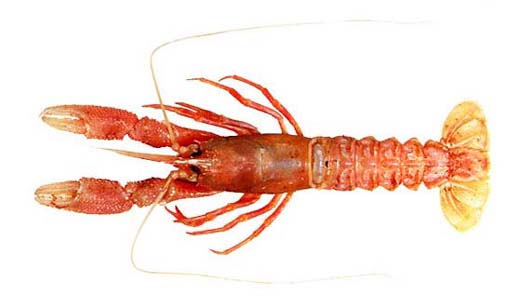アカザエビ科
- HOME
- デジタル図鑑
- パタゴニア海域の重要水族
- 節足動物門 甲殻綱 十脚目
- アカザエビ科
アカザエビ科(Nephropidae)

136 オキナエビモドキ(Okinaebi-modoki)
Thymops birsteini(Zarenkov et Semenov, 1972)
特 徴:
深海産の大形種で,体長20 cmを超える。頭胸甲は円筒系に近く,短毛でおおわれ,また,ごく微細な顆粒が一面にある。触角上棘は大きく,斜め前外方を向く。その後方に顆粒状突起があるのが普通。眼窩上棘があり,それに続いて数本の小さなとげが弱い稜をなして続く。額角は頭胸甲の約1/3の長さで,背面各側に普通2本のとげがある。とげは斜め外上方を向くが,左右で位置がずれていることが多い。額角の亜正中部は稜をなして後方にのび,眼窩上棘からの稜と並ぶ。稜上には小さなとげが並び,また,亜正中稜の後端部すなわち頭胸甲の胃上部では顆粒が大きい。額角の正中溝は頭胸甲の後端まで線状の溝として達する。頭胸甲の側面では触角溝とそれに続く肝溝,上にのびる短い頸溝,斜めに頭胸甲を横断する頸後溝が深い。頸後溝は背面で左右が合する。腹部背面は彫刻が明瞭で,各節とも前縁に沿って横溝が走る。第2節以後ではこの溝から後方に滑らかな縦の隆起があり,その左右表面および後縁部にも滑らかな浮彫りとなっている。第2〜5腹節の側甲は先端がとげ状。第6腹節の後縁には正中部と各側端に合計3本のとげがある。尾節の側縁の末端近くに1本のとげがあり,また中央に1本あることもある。第1胸脚は長くなく,背腹に扁平。鋭い突起でおおわれ,掌部上面中央を縦走する稜上では突起がやや大きい。歩脚は太く,前2対にはさみをもつ。
分 布:
南緯40度以南のアルゼンチン沖大陸斜面,およびチリ沿岸。Zarenkov(1976)はサウスジョージア島西方から記録している。水深135〜1,660 mに生息するが,むしろ500 m以深に多い。
備 考:
Holthusis(1974)はThymops, Thymopsisを創設し,既知のNephropsis Wood-MasonおよびNephropides ManningとともにThymopinae亜科を新設した。
文 献:
Zarenkov and Semenov (1972); Holthuis (1974).
(武田正倫)
Material examined:
FSFL EL802, EL803 (3♂♂-49°05′S, 59°52′W, 394 m deep; May 2, 1978); EM286 (2♀♀-39°30′S, 54°47′W, 1,222 m deep; June 7, 1978); EM593 (1♂-37°28′S, 54°27′W, 810 m deep; June 19, 1978); EL911 (1♀-39°30′S, 55°32′W, 719 m deep; July 19, 1978). Total length from tip of rostrum to posterior margin of telson, 12.5-23 cm.
Description:
A deep-sea large species. Carapace cylindrical, being thickly covered with fine granules and short setae; a tuberculate granule at some distance behind antennal spine; a small supraorbital spine followed by a weak ridge with some spinules; antennal and hepatic grooves distinct, cervical groove being extended above as a branch of antennal groove; postcervical groove prominent and oblique, sellar groove meeting with postcervical groove on median line. Rostrum about as long as one-third the length of carapace, being usually armed with 2 pairs of spines; median groove of rostrum deep and extended back as a linear furrow to posterior margin of carapace. Abdomen with deep sculpture, with an anterior transverse and a median longitudinal grooves; each pleura of second to fifth segments tipped with a spinule; sixth segment with 3 spines on posterior margin, and sometimes with a spine on median part of upper surface. Telson with 1 or 2 spines on each lateral margin. First 3 pereiopods chelate, the first being very heavy, rather depressed and covered with many spinules.
Distribution:
Known from cotinental slope off Argentina and Chile, 135-1,222 m deep, and otherwise Zarenkov (1976) recorded from far west of South Georgia, 1,660 m deep.
Remarks:
Holthuis (1974) erected a new subfamily Thymopinae to accomodate his new genera Tymops and Thymopsis as well as Nephropsis Wood-Mason and Nephropides Manning. It is distinguished from the Nephropinae by having no scaphocerite, the absence of postrorbital spine, the abdominal sternites unarmed in both sexes, and having no podobranch on the second maxilliped.
(Masatsune TAKEDA)

Distribution of Thymops birsteini in Patagonia.
- 1